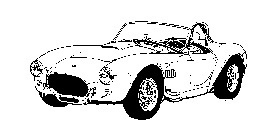
I took my Cobra down to the track,
hitched to the back of my Cadillac,
Everyone was there just a waiting for me There were plenty of Stingrays and XKEs…
(written by Carol Conner)
The Rip-Chords – 1964
It’s just a shame that, according to the U.S. Trademark Trial and Appeal Board (“Board”), your 1965 Cobra 427, the one you recently purchased for just $800,000, has not acquired distinctiveness — at least not for trademark purposes. Here’s why. In 1999, the Carroll Hall Shelby Trust (“Shelby”) filed a trademark application to register the “distinctive” shape of the Cobra 427 S/C vehicle. Upon publication, in November 2001, the application was immediately opposed by Factory Five Racing, Inc. (“Factory Five”) on several grounds, the most important being that the Shelby design had not acquired distinctiveness.
A little background is in order. In the early 1960s, Shelby partnered with Ford to produce high performance sports cars under the “Cobra” brand. Although Cobra production ceased in 1968, numerous third parties started producing Cobra replica kits, including the Cobra 427 S/C. This was despite Shelby’s attempts at stopping them. Then, in the early 1990s, presumably under the theory that if you can’t beat em, join em, Shelby released its own so-called “continuation” models, also in the form of kits. The question before the Board was whether purchasers of kits recognized Shelby as the source of their vehicles, in which case the trademark would issue, or whether the design lacked acquired distinctiveness, meaning that Factory Five would prevail in its opposition.
The Board determined that its analysis was not dependent upon the resale value or popularity of the original Cobra production models. Nor was it persuaded by Shelby referring to his own kits as “continuations” of the original production models. More important was that Shelby’s own kits were not heavily marketed; since the 1970s, nearly 200 other parties had marketed Cobra kits despite Shelby’s attempts at selling some of them licenses. The Board noted that more unauthorized third-party replica kits have been sold over the years than either the original Cobras or authorized replicas. One web site cited by the Board stated that “The Cobra became the most replicated design in automotive history with literally hundreds of companies capitalizing on the popularity of the design.” The New York Times wrote in 2009 that “The car’s [Cobra’s] history has fueled an industry that makes relatively low-cost Cobra replicas.” Shelby’s own enforcement efforts were at best paltry and unconvincing. Shelby’s most important evidence, a customer survey performed by its expert, was rejected by the Board as ambiguous and lacking reliability. The expert wasn’t even sure that the picture of the Cobra used with survey was that of the car at issue in the opposition action.
So Shelby had a long row to hoe. Well-established law provides that “configurations of products are not inherently distinctive and may only be registered as marks upon a showing of acquired distinctiveness.” (Wal-Mart Stores, Inc. v. Samara Bros, Inc. 529 US 205). To establish acquired distinctiveness, the trademark applicant must show — by direct or circumstantial evidence — that the primary significance of the product configuration in the minds of consumers is not the product but the source of that product. The Board concluded that Shelby’s circumstantial evidence that kit purchasers perceived Shelby as the source of their kits was weak and that his direct evidence — the survey results — was flawed and “of little or no probative value.” The Board sustained Factory Five’s opposition and held that Shelby failed to meet his burden of proof that the Shelby design mark had acquired distinctiveness. This case underlines the importance of policing your marks and obtaining reliable experts when its your turn to defend your mark.
— Adam G. Garson, Esq.

